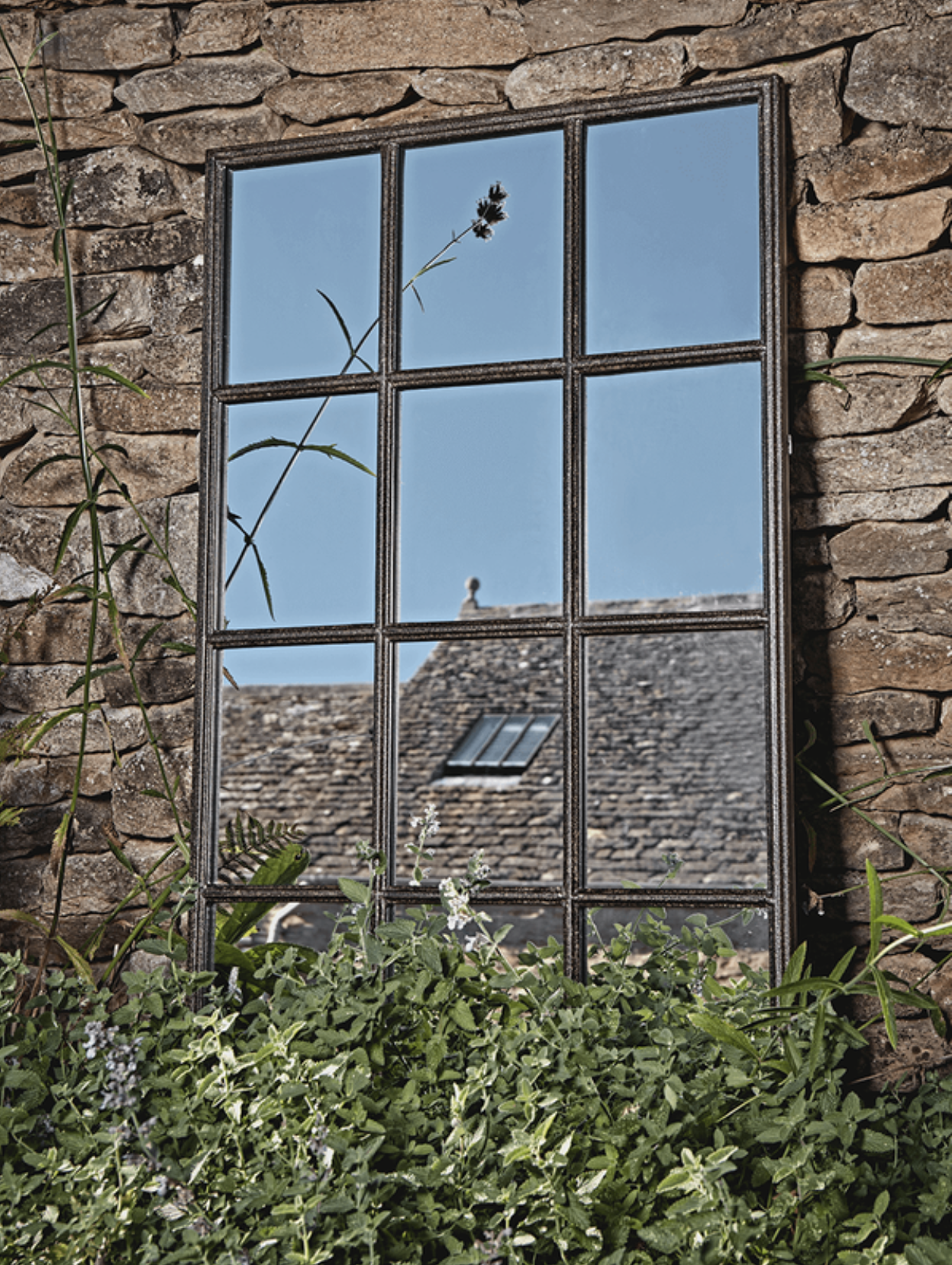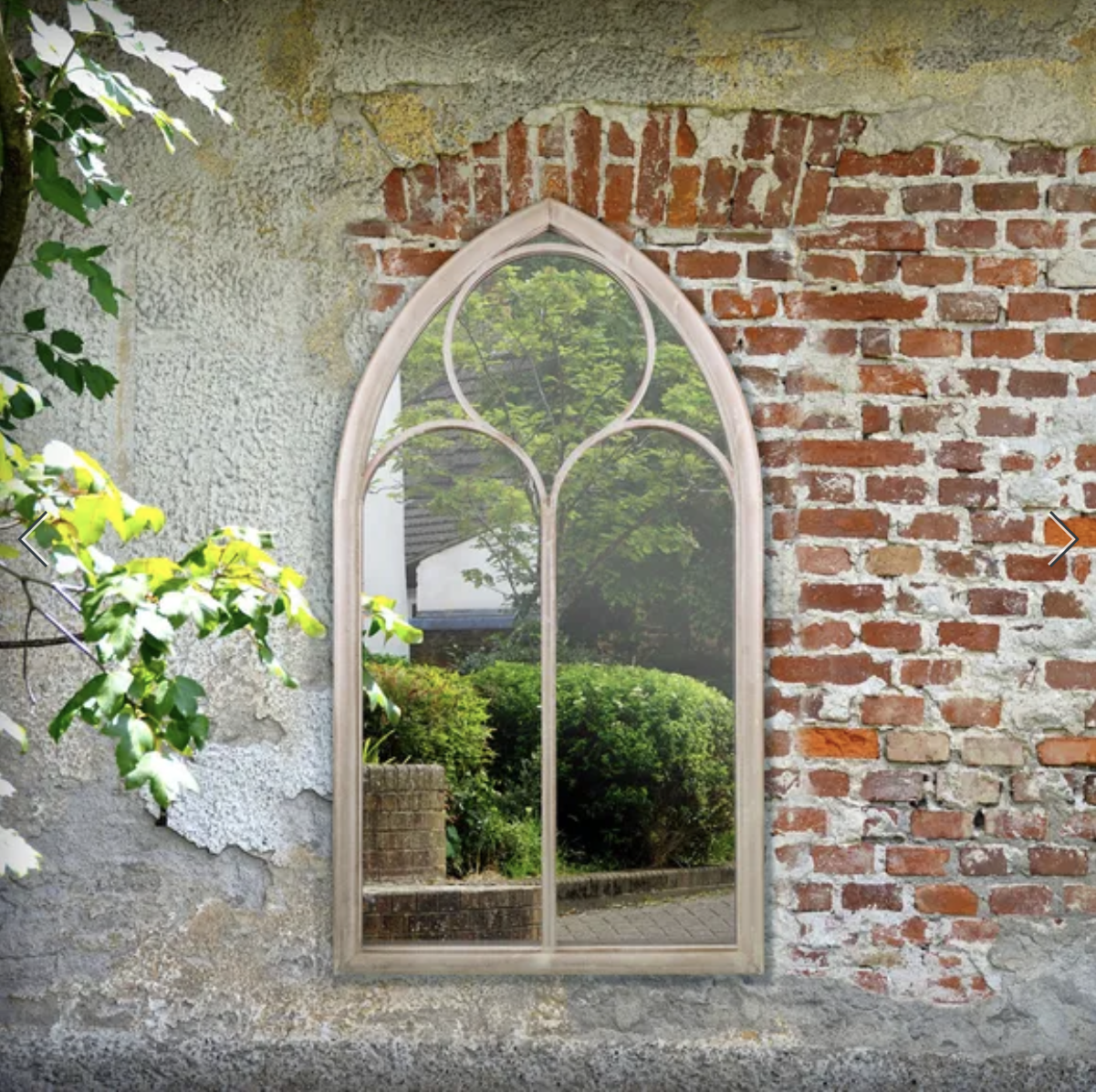We recently discussed how outdoor mirrors are a great accessory to pair with our outdoor furniture sets. If your outside space is limited or you want to hide an ugly brick wall then they are great for creating the illusion of more space and adding a focal point to draw the eye.
This, of course, is true, however, we felt it was a little thrown away, and just added on at the end of that article. There is so much more to outdoor mirrors and we feel they deserve a full post of their own.
There are many a do and don't to incorporating them into your garden too. And just as they can transform a garden for the better, get it wrong, and they can make it look, well, a little off. And that's us being polite.
Outdoor mirrors are a great way to create the illusion of more space, but they can also make things look fussy, confuse the eye, and highlight things in your garden that you might not want to draw attention to.
Strategically placing a garden mirror will bring a new dimension to your garden though, with the reflections creating a much greater sense of space and light.
However, put your outdoor mirror in the wrong place, and the only thing you could end up reflecting is a brick wall with drain pipes and that air vent from your extractor fan.
The key is to reflect the good. Trees, shrubs, plants, garden art, sculptures, water features etc. To add greater depth and visual interest or to use them like a window or doorway.
The Sassetti Outdoor Window Mirror (above) achieves this to perfection and is the perfect foil to bring colour and interest to the rustic brick wall.
Go to any good garden show this year and you'll find many an outdoor mirror. Top designers will often cleverly place garden mirrors in order to give their planting schemes and overall designs even greater depth/visual interest.
We realised we hadn't actually looked at outdoor mirrors in any great detail, so with this post hopefully I can rectify that. They can be a great feature, but it is very easy to get them wrong.
So here are some of our outdoor mirror do's and don'ts. We don't currently sell garden mirrors, so this is an impartial post. Just sharing the benefit of the little wisdom we have picked up over many years selling outdoor furniture.
How to make the best use of outdoor mirrors

In our recent small garden furniture ideas post we highlight how a well-placed outdoor mirror such as Cox & Cox's Industrial Outdoor Window Mirror (above) is perfect for reflecting light into the more shaded corners of your garden or creating the illusion of more space.
However, there are several factors you need to take into account to get the best results and ensure that the mirrors are positioned for maximum impact.
What shape outdoor mirror should you purchase?
We don't want to tell you exactly what type of garden mirror you should use. You need to analyse the space you have and how you want it to function. Is it more light or the illusion of more space?
Using some small round mirrors will help to create a window-like effect. They can be positioned to reflect light to parts of your garden that don't see any direct sunlight.
A large full-length mirror such as the Arch Tall Outdoor Mirror from Coopers (below) on the other hand can be utilised to create that illusion of more space. Position at ground level and it will create the illusion of a doorway to another garden.
Larger rectangular-shaped mirrors can also be mounted at eye level. Hang landscape and they'll add greater width to a narrow plot or portrait will help to give your garden a little more height.
Test, before you fix in place, is the best advice we can give. Also, think about what lighting effects the mirror will create at different times of the day. Or, if the light is not an issue, use the mirror to simply add an artistic element to your garden just as you would inside your home.
A word of caution
The key to getting the right size and shape garden mirror is keeping it understated. Getting the mirror to look like it belongs, enhances but blends into its surroundings.
And it's important that you only use mirrors that are specifically designed for outdoor use too such as the Decorative Round Garden Mirror from Hand Crafted Mirrors (above). Beautiful as it may be, more art than a mirror, it is designed specifically for outdoor use.
Any mirror you purchase must be able to stand up to the elements, and in the UK that means everything from warm sun to below zero temps, and everything else in between.
Many modern garden mirrors on the market are cut from reflective acrylic, as it is safer, more cost-effective and will stand up to the elements.
However, that's not to say you have to go with acrylic though. There's also a wide variety of aluminium glass mirrors that are suitable for outdoor use.
Frost and heatproof, they come in a wide array of designs. And whilst a little more expensive, they do have a little more of a quality look to them in our opinion. But we'll be honest, we're not such fans of acrylic, but some of the modern styles do look good, and the quality is improving.
Another area of caution is wildlife. Don’t place outdoor mirrors where they could impact bird flight and never place them in parts of your garden that get direct sunlight for long periods. Whilst they're unlikely to start a fire, they will create glare or you could crack them.
What size outdoor mirror do you need?
The size of the mirror simply comes down to the effect you are trying to create. What do you want the outdoor mirror to do? Size depends on so many factors, that it's really up to you what works and fits in your garden.
There are a number of different effects you can achieve with an outdoor mirror, and that is what will inform the right size.
If you want to create a small window-like portal, then go for a window-sized mirror such as the Woodside Upton Large Decorative Round Outdoor Garden Mirror (pictured above). If you want to create the look of a door you can walk through, then you need a full-length mirror.
Check measurements carefully before you buy and make sure the mirror you want will fit. You don't want it to dominate the space, but at the same time, you don't want it to get lost.
Strike a balance. Use other features in your garden as reference points, and choose a mirror that works with your overall scheme.
There are no absolutes in garden design, you could even say rules are there to be broken. It's what works for you and your outdoor space that's key here.
However, a basic rule of thumb, if you want to use the mirror like a window/picture frame on a wall or fence, is to leave at least 30cm above and below your mirror. For a full length, just 30 cm above.
Any less and the mirror can look a little too big. But as I say that's just a guide, only you can determine what's best for the space you have. What scale will work best?
Where should you hang your outdoor mirror?
When it comes to where you place your mirror, again it is much like the size.
The items surrounding the mirror will ultimately dictate how successful an illusion you create. Just having an outdoor mirror on its own with nothing around it will not really deliver the effect you're looking for.
Placing a garden mirror correctly is a little more tricky than you might think too. There's a little trial and error, so the key here is to try before you fix. You have to be careful with what the mirror reflects back from key vantage points in your garden. Difficult to know until it's in place.
As we mentioned at the start of the article, you don't want to be sitting on your patio looking at a mirror that's reflecting drain pipes and the extractor vent.
For us, outdoor mirrors work best when there's lots of interesting planting around them such as you see in the photo above of the Somerley Country Arch Garden Mirror (above). It's back to the mirror being understated as though they belong. You want them to merge into the background and create an illusion.
If the view reflected back in your mirror isn’t exactly as you want it, then cheat. Fix a wooden batten behind one side of the mirror, angle it slightly, and improve what's reflected back.
In fact, slightly angling the mirror is a good thing regardless. It further creates illusions. As you walk towards it your reflection is not the first thing you see. You create more of a sense of mystery.
Scale is the key factor when it comes to any form of garden art, be it a mirror, planter or statue. Measure where you want to hang it.
If you’re hanging it above a flower bed/border, then I always think you shouldn't take up more than three-quarters of the bed/border. This will give the right amount of presence without dominating the garden.
A group of two or three smaller mirrors will often work better than one large mirror. Much the same as it would be inside the home.
Both options work well but produce different results. The longer or larger your mirror, the greater the impact it will have on the space. That might be what you're trying to achieve, however, I always feel subtle is best.
Hhopefully, we've covered most of the dos and don'ts. However, if you have any further questions, please drop them in the comments below!









